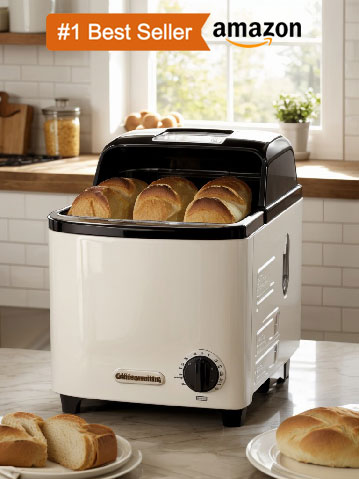How To Make Rolls In A Bread Machine
Bread machines offer an easy and convenient way to bake delicious homemade bread. With the use of a bread machine, you can make rolls with minimal effort and time. With a few simple steps, you can make warm, fluffy rolls that are perfect for any occasion.

Read the manufacturer's instructions for your specific bread machine model.
The instructions for my bread machine model include a variety of important steps for successful bread making. Before using the machine for the first time, users must thoroughly read the instruction manual and familiarize themselves with the various parts and functions of the machine. After gaining familiarity with the machine, users should then add ingredients according to their chosen recipe into the bread pan in the order suggested by the recipe.
After ingredients have been added, the bread pan should be placed into the machine and the lid closed. The user will then select the desired program and press start. The machine will then knead, rise, and bake the bread according to the selected program. Once the bread is finished, it is recommended that users remove the bread pan from the machine and allow the bread to cool for at least 10 minutes before slicing or serving.
Measure ingredients carefully and use only the amounts specified for your machine.
When measuring ingredients for your machine, it is important to be precise and to only use the amounts specified. This is because machines function differently from one another, and the recipes have been tailored to the specific type of machine that you are using. Too much or too little of an ingredient can lead to a poor outcome, so it is essential to measure the ingredients accurately.
Additionally, if you are substituting ingredients, be sure to look up the correct measurements for your machine. By taking the time to measure the ingredients carefully and using only the amounts specified for your machine, you can ensure that your recipe will turn out exactly as intended.
See also: Making Lemon Cake In A Bread Machine
Use ingredients that are fresh and at room temperature.
Using ingredients that are fresh and at room temperature is one of the keys to making a delicious dish. Fresh ingredients are full of flavor and nutrients, and their flavor is best when they are at room temperature. When a recipe calls for room temperature ingredients, make sure to take them out of the refrigerator an hour or two before you plan to start cooking.
This gives the ingredients time to adjust to room temperature. Room temperature ingredients are easier to work with, so they will blend together more evenly and quickly. This helps keep the dish from becoming overworked and ensures that the flavors of each ingredient come together to create a well-balanced meal. Additionally, using ingredients that are fresh and at room temperature can help reduce waste since they are less likely to spoil.
See also: Bread Machine Fruit Loaf For Australian Condigions
Make sure the yeast is fresh and not expired.
Yeast is an essential ingredient for baking and brewing, and it is important to make sure that the yeast you are using is fresh and not expired. To check the freshness of your yeast, start by looking at the expiration date on the package. If the packet has expired, you should discard it and purchase a new one.
You can also check the condition of the yeast by looking for any discoloration or clumps. Additionally, you can test the yeast's activity by combining it with a bit of warm water, some sugar, and a pinch of salt. If the mixture starts to foam and bubble, it means that the yeast is still active and fresh. If the mixture does not bubble, it is likely that the yeast has gone bad and should be discarded. Finally, make sure to store your yeast in a cool, dry place to ensure that it retains its freshness.
See also: How To Use Bread Mix In Bread Machine
Always proof the yeast prior to using it in the recipe.
Proofing the yeast is an important step in the baking process and should not be overlooked. This process verifies that the yeast is active and healthy, ensuring that your dough will rise properly during baking. To proof the yeast, you will need to combine it with warm water and a pinch of sugar.
The warm water should be between 105-115°F, as any hotter can kill the yeast. Once mixed, in about 5-10 minutes the mixture should become foamy, indicating that the yeast is alive. If the mixture does not foam, the yeast is no longer active and should not be used in the recipe. Once proofed, the yeast can be added to the other ingredients and should result in a successful bake.
See also: Sweet Cinnamon Rolls In The Bread Machine
Add wet ingredients first, then dry ingredients, and lastly the yeast.
When making bread from scratch, it is important to add the ingredients in the correct order to ensure the dough is properly mixed and rises correctly. Generally, the wet ingredients should be added first. This includes liquids such as water, milk, and oil, as well as any eggs or other wet ingredients such as honey or molasses.
Once the wet ingredients are added, the dry ingredients can be added. This usually includes the flour, salt, sugar, and any other dry ingredients such as spices or herbs. Finally, the yeast should be added at the end. It is important to wait until all of the other ingredients are already combined before adding the yeast, as it will activate and begin to work right away. Adding the yeast too early can lead to an uneven rise or a dense texture in the finished bread.
See also: Why Use Water Or Milk In Bread Machine
Select the correct cycle or setting for making rolls in your machine.
When making rolls in a bread machine, the best cycle or setting to use is typically the "dough" setting. This setting will mix the ingredients together, knead the dough, and then allow it to rise. After the dough has risen, you can then shape it into rolls and either let them rise again before baking them or bake them right away.
To bake the rolls, you can use the "bake" setting on your bread machine or you can transfer them to a preheated oven. Depending on the type of rolls you're making, the bake time will vary, so be sure to check the recipe for recommended bake time and temperature.
Grease the roll pans before adding the dough.
Greasing the roll pans before adding the dough is an important step in ensuring that the rolls are easy to remove from the pans once they have finished baking. To grease the pans, a light coating of either cooking oil, butter, or shortening should be applied. Depending on the size of the pan, the amount of grease used should be enough to lightly cover the entire bottom and sides of the pan.
This will help prevent the rolls from sticking while they are baking and will help release them from the pan easily when they are done. It is also important to make sure that all of the excess grease is wiped away before adding the dough. This will help ensure that the rolls will not be greasy when they are finished baking. Taking the time to properly grease the roll pans before adding the dough will ensure that the rolls are perfectly cooked and easy to remove from the pans.
Allow for adequate rising time for the dough before baking.
When making dough, it is important to allow for adequate rising time before baking. The rising time is necessary as it helps the yeast to activate, which produces carbon dioxide as a byproduct and causes the dough to expand. This expansion helps to create a lighter and airier texture in the finished product.
Generally, most dough recipes will recommend a minimum rising time of one hour. However, the rising time can vary depending on the recipe and the environment. If a recipe does not specify a rising time, it is best to err on the side of caution and allow for at least one hour of rising time before baking. Additionally, if the dough has been refrigerated for an extended period of time, it may require more rising time than usual. The dough should be allowed to double in size before baking, as this will ensure that the final product is light and fluffy.
Monitor the rolls while baking and adjust time and temperature as necessary.
When baking rolls, it is important to monitor them regularly to ensure they are baking correctly. The temperature and time may need to be adjusted as the rolls bake. The temperature should be set according to the recipe and then adjusted if needed.
The rolls should be checked after about 10 minutes to make sure they are baking evenly. If one side is getting too brown, the temperature should be lowered. The rolls should also be rotated in the oven to ensure even baking. The rolls should be checked with a toothpick or cake tester for done-ness. If it comes out clean, the rolls are done. If it comes out with dough on it, the rolls should bake for a few more minutes. Once the rolls are done, they should be removed from the oven and allowed to cool before serving. It is important to monitor the rolls while baking to ensure that they come out perfectly cooked and delicious.





